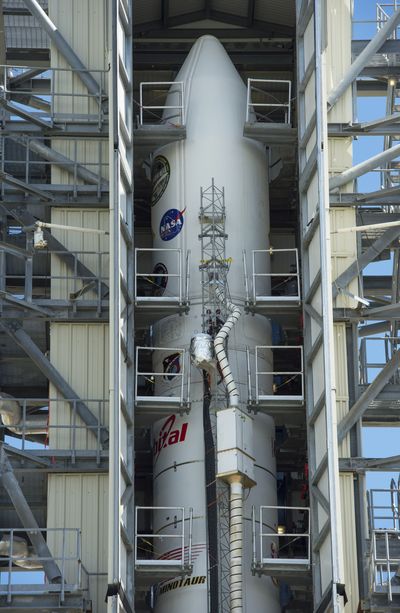NASA launches moon explorer
Successful Virginia liftoff wows East Coast spectators

NASA’s newest robotic explorer rocketed into space late Friday in an unprecedented moonshot from Virginia.
The LADEE spacecraft, which is charged with studying the lunar atmosphere and dust, soared aboard an unmanned Minotaur rocket a little before midnight, dazzling spectators along the East Coast.
Flight controllers applauded and exchanged high-fives following the successful launch. “We are headed to the moon!” NASA said in a tweet.
It was a change of venue for NASA, which normally launches moon missions from Cape Canaveral, Fla. But it provided a rare light show along the East Coast for those blessed with clear skies.
NASA expected the launch from Virginia’s Eastern Shore to be visible, weather permitting, as far south as South Carolina, as far north as Maine and as far west as Pittsburgh.
The space agency urged sky watchers to share their launch pictures through the website Flickr, and the photos quickly poured in from New York City, Boston, Washington, D.C., Baltimore, New Jersey, Rhode Island, eastern Pennsylvania and Virginia, among other places.
The Lunar Atmosphere and Dust Environment Explorer or LADEE, pronounced “LA’-dee,” is taking a roundabout path to the moon, making three huge laps around Earth before getting close enough to pop into lunar orbit.
Unlike the quick three-day Apollo flights to the moon, LADEE will need a full month to reach Earth’s closest neighbor. An Air Force Minotaur V rocket, built by Orbital Sciences Corp., provided the ride from NASA’s Wallops Flight Facility.
LADEE, which is the size of a small car, is expected to reach the moon on Oct. 6.
Scientists want to learn the composition of the moon’s ever-so-delicate atmosphere and how it might change over time. Another puzzle is whether dust actually levitates from the lunar surface.
The $280 million moon-orbiting mission will last six months and end with a suicide plunge into the moon for LADEE.
The 844-pound spacecraft has three science instruments as well as laser communication test equipment that could revolutionize data relay.
It was a momentous night for Wallops, which was making its first deep-space liftoff. All of its previous launches were confined to Earth orbit.
Wallops will be back in the spotlight in less than two weeks. Virginia-based Orbital Sciences will make its first delivery to the International Space Station, using its own Antares rocket and Cygnus capsule. That launch is scheduled for Sept. 17.